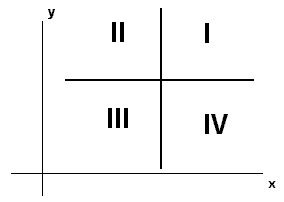Systems of Differential Equations: Models of Species Interaction
Part 3.1: Competing Species I
Now we will look at a system of equations that is very similar to the predator-prey system. Indeed the only difference is a change in sign of some of the coefficients.
dx/dt = ax - bxy
dy/dt = cy - pxy
We still assume that a, b, c, and p are positive constants.
-
(a) What are the sign changes in this system from the predator-prey system?
(b) Describe a biological scenario with two populations for which this system of equations might apply.
- The new system again has an equilibrium point. Find formulas for the coordinates of this equilibrium point in terms of a, b, c, and p.
Let (x0,y0) be the equilibrium point for the general system
The lines x = x0 and y = y0 divide the first quadrant in the xy-plane into four subregions as indicated below.

For each subregion indicate whether x is increasing or decreasing and whether y is increasing or decreasing.
- Using paper and pencil, sketch in what you think the pattern of the trajectories should look like.
- Let a = 1, b = 0.1, c = 1, p = 0.2, and use your computer algebra system to draw the direction field and several trajectories for this system. Do they agree with your pencil and paper sketch?
-
(a) What is the difference between the behavior of trajectories near the equilibrium point for this system and the behavior of trajectories near the equilibrium point for a predator-prey system?
(b) Does this seem reasonable in terms of the biological population description you gave in Step 1? Explain why or why not.
-
(a) How do the trajectories of solutions to the system change as you vary the ratio b/p? Does this seem reasonable in terms of the biological population description you gave in Step 1? Explain why or why not.
(b) How do the trajectories of solutions to the system change as you vary the ratio a/c? Does this seem reasonable in terms of the biological population description you gave in Step 1? Explain why or why not.
